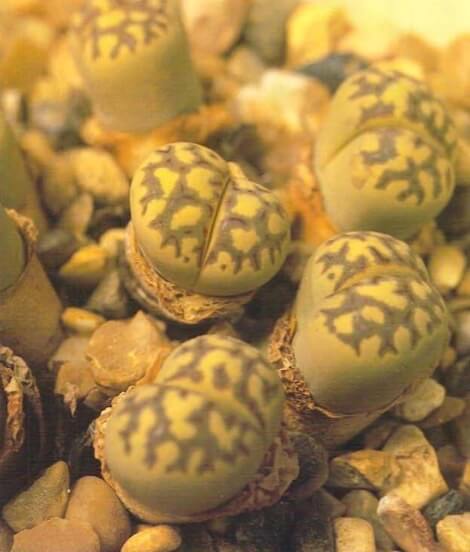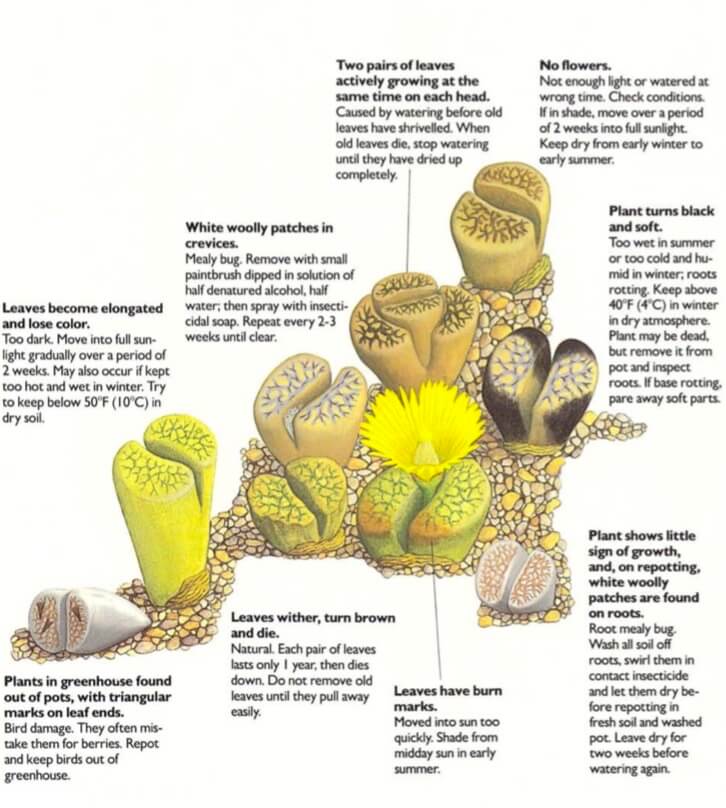[Ebook Việt Hoá] The Instant Guide to Healthy Houseplants (Hướng dẫn tức thời để chăm cây trong nhà khoẻ mạnh), Chi Lithops
[Ebook Việt Hoá] The Instant Guide to Healthy Houseplants: Lithops (Living stones, Flowering stones, Stoneace, Mimicry plant)
- Nguồn: [Ebook Việt Hoá] The Instant Guide to Healthy Houseplants (Hướng dẫn tức thời để chăm cây trong nhà khoẻ mạnh)
- Biên tập: Dũng Cá Xinh
- Biên dịch: Team Codai.net
English
This is a wonderful genus of South African plants adapted to survive long, extreme droughts. They are good indoor or greenhouse plants and do well provided that they get plenty of sunlight and that they are watered according to instructions. In their winter rest period, new leaves grow and push through the old ones, which shrivel and dry up completely. It is most important that the plants receive no water at this time. The Rowers, either yellow or white, appear in late summer or early autumn. Reliable species include L. optica fa. rubra, with purple-pink stems; L. dorotheae; L. otzeniana; L. werneri; and L. lesliei.

Light
Maximum sunshine is needed for these plants to ensure compact growth, good coloring and flower production.
Temperature
Tolerates low temperatures in the winter, but a minimum of 40°F (4°C) is safer. In summer, give fresh air whenever possible.
Water
Start watering when the shrivel touch, usually in early summer. Thereafter. water about once every two weeks or even very week in the hottest months. Stop altogether in the early winter, and do not start again until leaves have dried out once more.
Feeding
If not repotted in spring, feed twice during the summer using high-potash fertilizer. Feeding is not needed if plant has been repotted.
Soil
Use good loam-based potting soil, or soilless mix, with about 40 percent coarse, gritty sand.
Repotting
Transfer every spring into halfpot next size larger, being careful not to disturb roots.
Propagation
Grow usually from seed, although whole stems may be rooted in springtime.
Propagation
- 1. If plant has formed a clump, remove single heads in spring.
- 2. Dust base with hormone rooting powder and let dry for 2-3 days.
- 3. Place on surface of drysoil and do not water until roots appear.

Removing dead flowers
Do not pull away dead flower heads; let them shrivel away. only picking out by hand when they pull away easily. Pulling them out earlier may damage leaves.
What Goes Wrong

- Leaves become elongated and lose color: Too dark. Move into full sun- light gradually over a period of 2 weeks. May also occur if kept too hot and wet in winter. Try to keep below 50°F (10°C) in dry soil.
- Two pairs of leaves actively growing at the same time on each head: Caused by watering before old leaves have shrivelled. When old leaves die, stop watering until they have dried up completely.
- White woolly patches in crevices: Mealy bug. Remove with small paintbrush dipped in solution of half denatured alcohol, half water; then spray with insecticidal soap. Repeat every 2-3 weeks until clear.
- No flowers: Not enough light or watered at wrong time. Check conditions. If in shade, move over a period of 2 weeks into full sunlight. Keep dry from early winter to early summer.
- Plant turns black and soft: Too wet in summer or too cold and humid in winter; roots rotting. Keep above 40°F (4°C) in winter in dry atmosphere. Plant may be dead, but remove it from pot and inspect roots. If base rotting, pare away soft parts.
- Plant shows little sign of growth, and, on repotting, white woolly patches are found on roots: Root mealy bug. Wash all soil off roots, swirl them in contact insecticide and let them dry be- fore repotting in fresh soil and washed pot. Leave dry for two weeks before watering again.
- Plants in greenhouse found out of pots, with triangular marks on leaf ends: Bird damage. They often mistake them for berries. Repot and keep birds out of greenhouse.
- Leaves wither, turn brown and die: Natural. Each pair of leaves lasts only 1 year, then dies down. Do not remove old leaves until they pull away easily.
- Leaves have bum marks: Moved into sun too quickly. Shade from midday sun in early summer
Tiếng Việt
Đây là một chi tuyệt vời của các loài thực vật Nam Phi có thể sống trong thời gian dài và điều kiện hạn hán khắc nghiệt. Chúng là những cây trồng trong nhà hoặc trong nhà kính tốt với điều kiện nhận được nhiều ánh sáng mặt trời và được tưới theo hướng dẫn. Trong thời kỳ nghỉ đông của chúng, những chiếc lá mới mọc ra và đẩy những chiếc lá cũ, chúng sẽ co lại và khô hoàn toàn. Điều quan trọng nhất là không được tưới cây vào thời điểm này. Rowers, có màu vàng hoặc trắng, xuất hiện vào cuối mùa hè hoặc đầu mùa thu. Các loài đáng tin cậy bao gồm L. optica fa. rubra, có thân màu hồng tím; Họ L. dorotheae; L. otzeniana; L. werneri; và L. lesliei.

Ánh sáng
Cung cấp ánh nắng tối đa cho những cây này để đảm bảo cây phát triển gọn gàng, màu sắc tốt và ra hoa.
Nhiệt độ
Chịu được nhiệt độ thấp vào mùa đông, nhưng tối thiểu là 40 ° F (4 ° C) sẽ an toàn hơn. Vào mùa hè, cung cấp không khí trong lành bất cứ khi nào có thể.
Nước
Bắt đầu tưới nước khi chạm vào thấy nhăn, thường là vào đầu mùa hè. Sau đó, tưới khoảng hai tuần một lần hoặc thậm chí rất nhiều tuần trong những tháng nóng nhất. Ngừng hoàn toàn vào đầu mùa đông và không bắt đầu lại cho đến khi lá khô một lần nữa.
Bón phân
Nếu không thay chậu vào mùa xuân, hãy bón phân hai lần vào mùa hè bằng cách sử dụng phân bón có hàm lượng kali cao. Không cần bón phân nếu cây đã được thay chậu.
Đất
Sử dụng đất bầu loại tốt, hoặc hỗn hợp không có đất, với khoảng 40% cát thô, sạn.
Thay chậu
Mỗi mùa xuân sang chuyển vào chậu có kích thước lớn hơn, cẩn thận để không làm xáo trộn rễ.
Nhân giống
Thường mọc từ hạt, mặc dù toàn bộ thân cây có thể ra rễ vào mùa xuân.
Cách nhân giống
- 1. Nếu cây đã mọc thành chùm, hãy loại bỏ những ngọn đơn lẻ vào mùa xuân.
- 2. Rắc lên gốc lớp bột kích thích tố ra rễ và để khô trong 2-3 ngày.
- 3. Đặt trên bề mặt đất khô và không tưới nước cho đến khi rễ xuất hiện.

Loại bỏ hoa tàn
Không nhổ bỏ các đầu hoa đã chết; hãy để chúng héo đi và chỉ hái bằng tay khi chúng dễ dàng loại bỏ. Ngắt chúng ra sớm hơn có thể làm hỏng lá.
Những vấn đề có thể xảy ra

- Lá dài ra và mất màu: Quá tối. Chuyển dần ra nơi có ánh nắng đầy đủ trong khoảng thời gian 2 tuần. Cũng có thể xảy ra nếu để quá nóng và ẩm ướt vào mùa đông. Cố gắng giữ dưới 50 ° F (10 ° C) trong đất khô.
- Trên mỗi đầu có hai cặp lá mọc cùng lúc: Nguyên nhân do tưới nước trước khi lá già héo. Khi lá già chết, ngừng tưới cho đến khi khô hẳn.
- Các mảng lông tơ trắng trong các kẽ hở: Rệp sáp. Loại bỏ bằng cọ nhỏ nhúng vào dung dịch một nửa cồn biến tính, một nửa nước; sau đó phun bằng xà phòng diệt côn trùng. Lặp lại 2-3 tuần một lần cho đến khi khỏi hẳn.
- Không ra hoa: Không đủ ánh sáng hoặc tưới không đúng thời điểm. Kiểm tra các điều kiện. Nếu ở trong bóng râm, di chuyển ra ánh sáng mặt trời đầy đủ trong khoảng 2 tuần. Giữ khô ráo từ đầu mùa đông đến đầu mùa hè.
- Cây chuyển sang màu đen và mềm: Quá ẩm ướt vào mùa hè hoặc quá lạnh và ẩm vào mùa đông; rễ bị thối rữa. Giữ trên 40 ° F (4 ° C) vào mùa đông trong bầu không khí khô. Cây có thể đã chết, nhưng hãy lấy cây ra khỏi chậu và kiểm tra rễ. Nếu phần đế bị thối rữa, hãy cắt bỏ những phần mềm.
- Cây có ít dấu hiệu phát triển và khi thay chậu, người ta tìm thấy những mảng lông tơ màu trắng trên rễ: Rệp sáp. Rửa sạch tất cả đất khỏi rễ, xoáy chúng vào thuốc trừ sâu tiếp xúc và để chúng khô trước khi thay vào đất mới và chậu đã rửa sạch. Để khô trong hai tuần trước khi tưới lại.
- Cây trồng trong nhà kính chồi khỏi chậu, có vết hình tam giác ở đầu lá: Hư hại do loài chim. Chúng nhầm tưởng với quả mọng. Thay chậu và không để chim xuất hiện trong nhà kính.
- Lá khô héo, chuyển sang màu nâu và chết: Tự nhiên. Mỗi cặp lá chỉ tồn tại được 1 năm, sau đó tàn lụi. Không loại bỏ lá già cho đến khi chúng dễ dàng hái xuống.
- Lá có vết xấu: Chuyển cây ra nắng quá nhanh. Che mát cho cây giữa trưa đầu hè.
![[Ebook Việt Hoá] The Instant Guide to Healthy Houseplants: Lithops (Living stones, Flowering stones, Stoneace, Mimicry plant) [Ebook Việt Hoá] The Instant Guide to Healthy Houseplants: Lithops (Living stones, Flowering stones, Stoneace, Mimicry plant)](https://vn1.vdrive.vn/codai.net/2020/02/ebook-huong-dan-tuc-thoi-cham-cay-trong-nha-khoe-manh-117-lithops.jpg)


